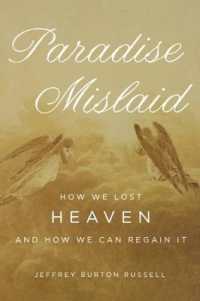- ホーム
- > 洋書
- > 英文書
- > Business / Economics
Full Description
The news is said to serve as 'social cement' (John C. Merrill), with journalists becoming 'search engines' (John Hartley) that help their audiences navigate the problems of everyday life. The centrality of journalism to modern society is obvious, as is the need to study journalism. However, no introductory textbook on journalism research has been published so far; journalism students are forced to acquire their knowledge of journalism research from various sources that do not deal exclusively with journalism research. The proposed textbook "Journalism Research: An Introduction" is intended to fill this gap. Aims and scope: As an introductory textbook, "Journalism Research: An Introduction" will provide a general and comprehensive overview of journalism research, its origins, historical trajectories, key findings, as well as its diverse theoretical and methodological repertoire. The book will provide the reader with a systematic, accessible description of key studies in journalism research along with a critical review of the various epistemological, theoretical, and methodological traditions.
The often scattered body of journalism research will be rearranged, systematized, assessed, and made available to students. Through the textbook, students will gain knowledge of the following essential aspects of journalism research: the theories, concepts, and definitions that drive journalism research; central research findings related to 'news people', as well as the language, routines, organizations, and cultures of journalism; key research findings on the relationship between journalism and politics, markets, technology, philosophy, and culture; and, an outlook on future directions of journalism research. Each chapter will start with 'classic' studies that have stood the test of time and made a lasting impact on journalism research. Students will be provided with methodological insights through a detailed discussion of these groundbreaking studies, with particular emphasis on the methodology used. Additionally, a selected number of outstanding journalism researchers will be introduced in brief biographical sketches.
By suggesting a concrete research agenda, the final section on future directions of journalism research is designed to motivate students to undertake their own research. Chapters will also include pedagogical features such as info boxes, interviews, summaries of important points, etc. Because journalism research increasingly transcends national and cultural boundaries, "Journalism Research: An Introduction" will target an international audience and be truly international in content. Although the choice of classic studies covered by the book reflects the fact that most influential work in journalism studies has originated from the United States and Europe, the textbook will also highlight selected works from other parts of the world, including Africa, Asia, and Latin America. The persistent Western bias in journalism research will be addressed at length in its own chapter.
Contents
PART I: INTRODUCTION.In the introductory section, we aim to answer two key questions: "What is journalism?" and."Why do we need journalism research?".1 What is journalism?.Definitions of journalism have evolved historically and developed over time. Consequently, this chapter will provide the reader with a brief history of journalism. Key definitions of journalism will be embedded in their respective historical and intellectual contexts. Given the international scope of the textbook, the definitions will be discussed with.reference to the various national traditions that have been prevalent in, for instance, the.United States, Great Britain, France, and Germany.2 Why journalism research?.3 Theories of journalism.4 Concepts of journalism.PART II: INSIDE JOURNALISM.This section examines the workings of journalism. These internal aspects of journalism include the individuals who produce the news, the language of journalism, the routines and.organizational structures of news making, and the cultures of journalism. Each section will.be based on a "classic" groundbreaking study that has left a lasting impression on journalism.research. Starting with these classic works, the subsequent research traditions will be described, classified, and briefly discussed. The use of data will be kept to a minimum, as it.often becomes rapidly outdated. Instead, we will focus on long-standing findings that have.stood the test of time.5 Overview: Levels of analysis.6 "News people": Gatekeepers at work.7 News narratives and storytelling.8 Patterns of journalistic practice.9 Editorial coordination and resources.10 Journalism's identity..PART III: JOURNALISM AND SOCIETY.This section will focus on the societal aspects of journalism. Journalism will be embedded in.the larger context of the society and culture in which it operates. The section will therefore.contextualize journalism and identify its importance for modern societies - not only at a national level, but a transnational one as well. The following chapters introduce the relationships between journalism and its most relevant and prominently discussed contextual fields,.including politics, the media economy, technology, philosophy, and culture. As in the previous section, each chapter will be based on a number of studies considered to be "classics.".11 Overview: Journalism as a social institution.12 Journalism and politics.13 Journalism and the market.14 Journalism and technology.15 Journalism and philosophy.16 Journalism and culture..PART IV: FUTURE DIRECTIONS.The last section will provide an outlook on future directions of journalism research. Issues to.be addressed include the object of inquiry (What is journalism?), theoretical developments.(Is a super-theory of journalism possible?), methodological issues (Do new methods allow.more insights?), and the development of the scientific discipline in a globalized environment.(Where is journalism research headed in a "globalized" world?). Journalism is an extremely.dynamic field of research, as indicated by some of the current developments in the field:.stronger community orientation, the "entertainization" of news, and alternative forms of.interactive journalism. The theoretical and methodological implications of these changes will.also be discussed.17 What is journalism, revisited.18 Is a super-theory of journalism possible?.19 Do new methods allow more insights?.20 Where is journalism research headed in a "globalized" world?.References.Index of Persons.Index of Key Concepts







